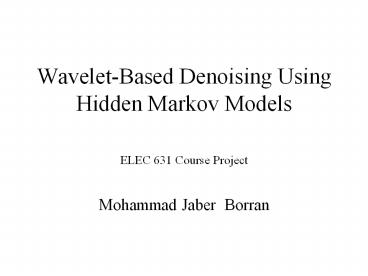Wavelet-Based Denoising Using Hidden Markov Models PowerPoint PPT Presentation
Title: Wavelet-Based Denoising Using Hidden Markov Models
1
Wavelet-Based Denoising Using Hidden Markov Models
- ELEC 631 Course Project
- Mohammad Jaber Borran
2
Some properties of DWT
- Primary
- Locality
- ? Match more
signals - Multiresolution
- Compression ? Sparse DWTs
- Secondary
- Clustering ? Dependency within scale
- Persistence ? Dependency across scale
3
Probabilistic Model for an Individual Wavelet
Coefficient
- Compression ? many small coefficients
- few large
coefficients
4
Probabilistic Model for a Wavelet Transform
5
Parameters of HMT Model
- pmf of the root node
- transition probability
- (parameters of the)
- conditional pdfs
- e.g. if Gaussian Mixture is used
q Model Parameter Vector
6
Dependency between Signs of Wavelet Coefficients
7
New Probabilistic Model for Individual Wavelet
Coefficients
- Use one-sided functions as conditional
probability densities
8
Proposed Mixture PDF
- Use exponential distributions as components of
the mixture distribution
If m is even
If m is odd
9
PDF of the Noisy Wavelet Coefficients
Wavelet transform is orthonormal, therefore if
the additive noise is white and zero-mean
Gaussian process with variance s2, then we have
Noisy wavelet coefficient,
If m is even
If m is odd
10
Training the HMT Model
- y Observed noisy wavelet coefficients
- s Vector of hidden states
- q Model parameter vector
- Maximum likelihood parameter estimation
Intractable, because s is unobserved (hidden).
11
Model Training Using Expectation Maximization
Algorithm
- Define the set of complete data, x (y,s)
- and then,
12
EM Algorithm (continued)
- State a posteriori probabilities are calculated
using Upward-Downward algorithm - Root state a priori pmf and the state transition
probabilities are calculated using Lagrange
multipliers for maximizing U. - Parameters of the conditional pdf may be
calculated analytically or numerically, to
maximize the function U.
13
Denoising
- MAP estimate
14
Denoising (continued)
- Conditional mean estimate
15
(No Transcript)
16
(No Transcript)
17
(No Transcript)
18
Conclusion
- Mixture distributions for individual wavelet
coefficients can effectively model the
nonGaussian nature of the coefficients. - Hidden Markov Models can serve as a powerful tool
for wavelet-based statistical signal processing. - One-sided exponential distributions for mixture
components along with hidden Markov Tree model
can achieve better performance in denoising.
19
(No Transcript)
20
(No Transcript)
21
(No Transcript)
22
(No Transcript)
23
(No Transcript)
24
(No Transcript)
25
(No Transcript)
26
(No Transcript)
27
(No Transcript)

